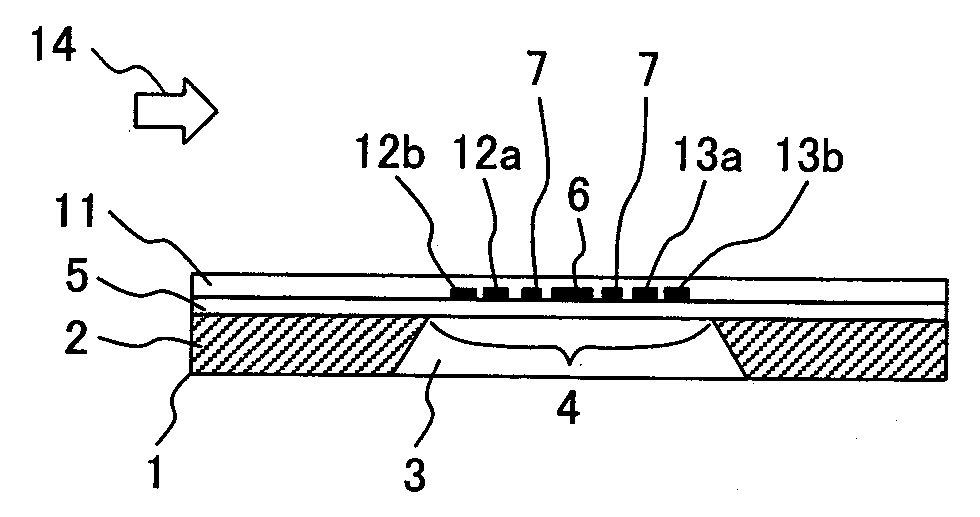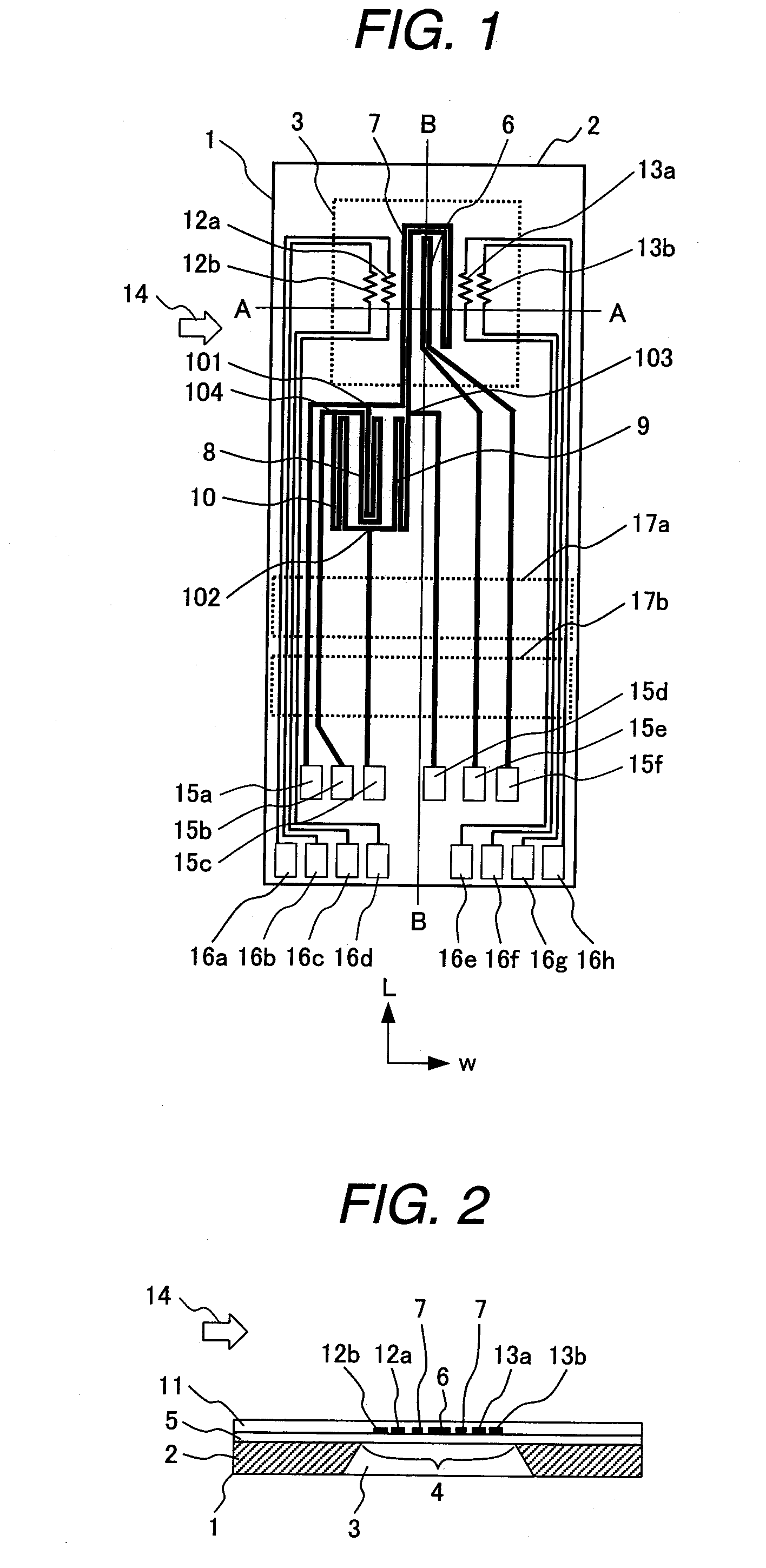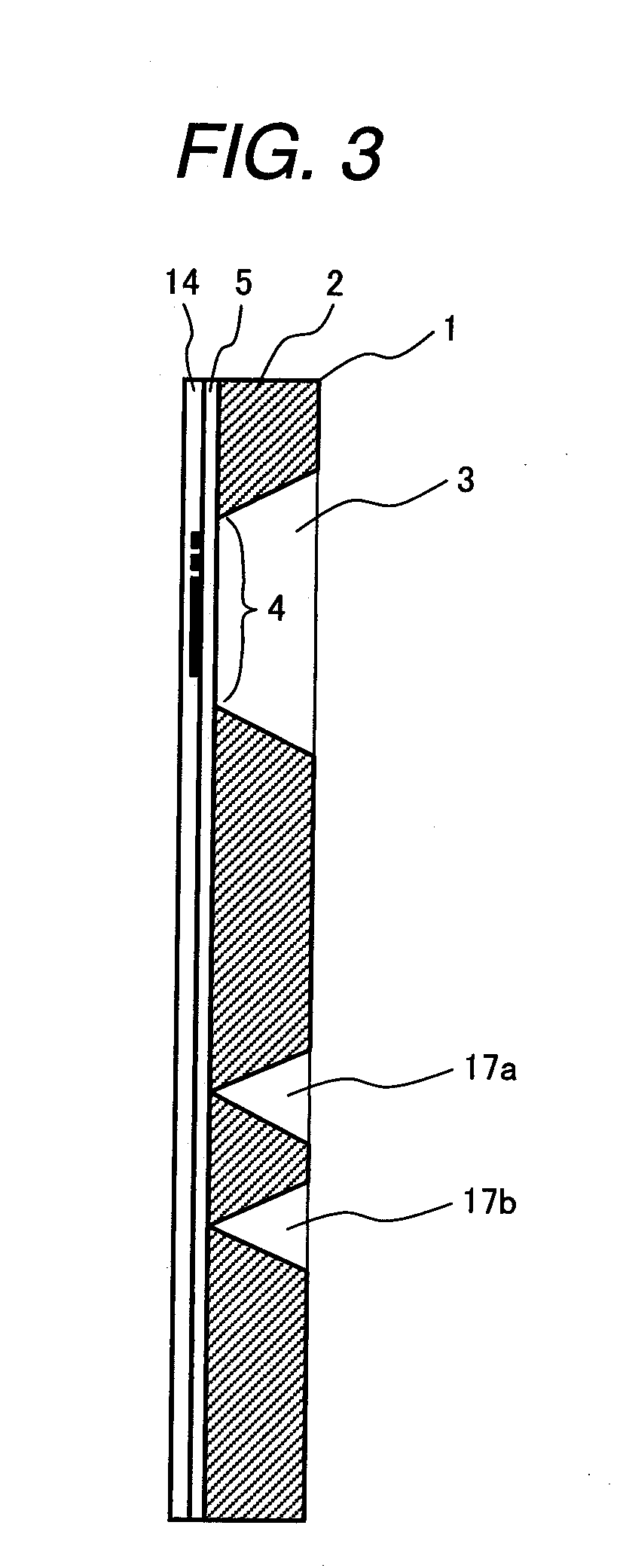Thermal type flow sensor
a flow sensor and flow rate technology, applied in the field of thermoplastic flow sensors, can solve the problems of deterioration, error in the temperature difference control of the resistive element, and deterioration of flow rate measurement precision, so as to reduce at least one and maintain the effect of measurement precision
- Summary
- Abstract
- Description
- Claims
- Application Information
AI Technical Summary
Benefits of technology
Problems solved by technology
Method used
Image
Examples
first embodiment
[0057]FIG. 1 is a schematic plan view showing a sensor element of a thermal type flow sensor according to this embodiment. FIG. 2 is a schematic diagram taken along a section A-A in FIG. 1, and FIG. 3 is a schematic diagram taken along a section B-B. In those figures, a base of a sensor element 1 is formed of a semiconductor substrate 2 such as a single crystal silicon (Si) plate. The semiconductor substrate 2 has a cavity portion 3 as a recess portion formed by subjecting one surface of the semiconductor substrate 2 to anisotropic etching. The planar configuration of the cavity portion 3 is square. One surface of the cavity portion 3 is formed with a diaphragm (thin-walled portion) 4. The diaphragm 4 is formed of an electric insulating film 5 that covers one surface of the semiconductor substrate 2. The electric insulating film 5 is made of silicon dioxide (SiO2) that is produced through thermal oxidation or a CVD (chemical vapor deposition) process.
[0058]Heat resistive elements 6,...
second embodiment
[0095]In the above embodiment, the temperature difference between the upstream and the downstream from the heat resistive elements (the temperature difference are formed by the heat resistive elements 6 and 7) is sensed by the temperature sensitive resistive elements 12a, 12b and 13a, 13b, to thereby sense the flow rate. Instead, it is possible to convert the current change that flows through the heat resistive element into an electric signal to sense the flow rate. For example, as shown in FIG. 26, the configuration of the sensor element can be proposed as follows. Namely, the sensor element is configured to sense the heating current for heat resistive elements at precedence position to the heat resistive elements 6 and 7 (the precedence position is located between the transistor 20 and the heat resistive elements 6, 7) and to convert the sensed current into a voltage to obtain an output 100. Thereby, the configuration makes it possible to sense the flow rate. Since the circuit sho...
third embodiment
[0096]FIG. 12 shows a plan view of a sensor element 26 according to this embodiment. A method of manufacturing the sensor element 26 is same as that of the first embodiment. The sensor element 26 is provided with a diaphragm (thin-walled portion) 27 as well as the first embodiment. Heat resistive elements 28, 29, 30, and temperature sensitive resistive elements 31a, 31b, 32a, and 32b are formed on the area of the diaphragm 27. Temperature sensitive resistive elements 33 and 34 are formed on places outside the diaphragm 27. As described above, the heat resistive element 29 corresponds to the first resistive element, the heat resistive element 30 corresponds to the fourth resistive element, and the heat resistive element 28 corresponds to the fifth resistive element.
[0097]FIG. 13 shows a driver circuit 35 of the sensor element 26. The bridge circuit is configured by connecting a first series circuit with a heat resistive element 29 (first resistive element) and a temperature sensitive...
PUM
 Login to View More
Login to View More Abstract
Description
Claims
Application Information
 Login to View More
Login to View More - R&D
- Intellectual Property
- Life Sciences
- Materials
- Tech Scout
- Unparalleled Data Quality
- Higher Quality Content
- 60% Fewer Hallucinations
Browse by: Latest US Patents, China's latest patents, Technical Efficacy Thesaurus, Application Domain, Technology Topic, Popular Technical Reports.
© 2025 PatSnap. All rights reserved.Legal|Privacy policy|Modern Slavery Act Transparency Statement|Sitemap|About US| Contact US: help@patsnap.com



